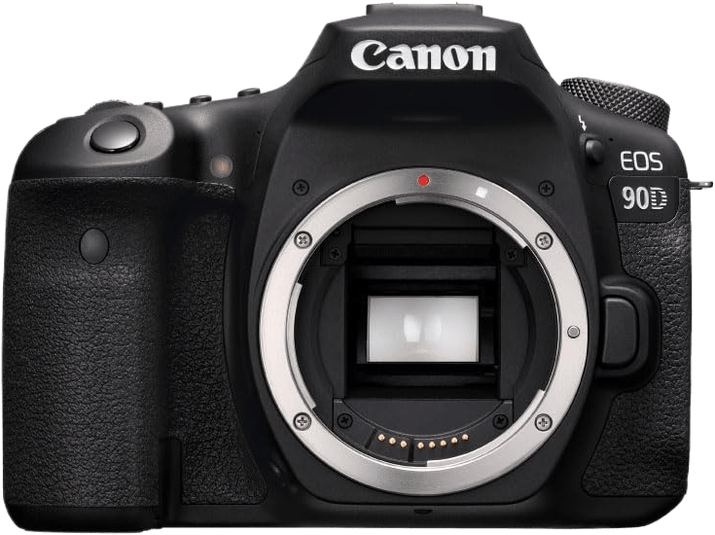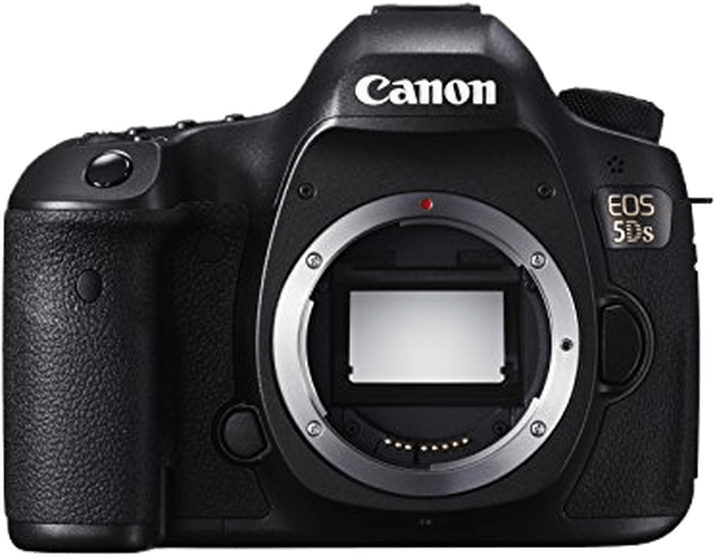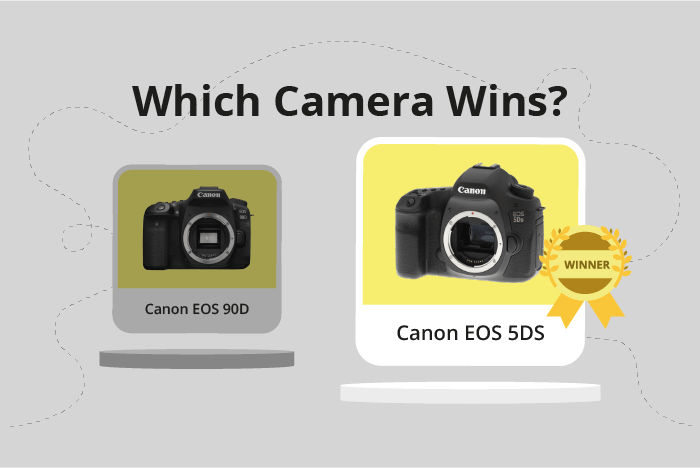Canon EOS 90D vs EOS 5DS Comparison
Canon EOS 90D

Canon EOS 5DS

The Canon EOS 5DS outperforms the Canon EOS 90D with a score of 69 to 67. Both are DSLR cameras, launched in 2015 and 2019 respectively. They share common specifications, such as camera type and similar dimensions. However, the 5DS is heavier at 930g compared to the 90D’s 701g.
The EOS 5DS’s higher score indicates its superiority in certain aspects. On the other hand, the EOS 90D has advantages too, such as a lower launch price of $1199 compared to the 5DS’s $3700, and a lighter body, making it more portable.
Taking these factors into account, the EOS 5DS may be a better choice for those seeking higher performance, while the EOS 90D could be more suitable for budget-conscious and on-the-go photographers.
Canon EOS 90D vs EOS 5DS Overview and Optics
The Canon EOS 5DS outperforms the Canon EOS 90D in optics with a score of 73/100 compared to the 90D’s 62/100. Both cameras share common specifications such as the CMOS sensor type, Canon lens mounts, and lack of image stabilization. However, there are key differences that put the 5DS ahead of the 90D in terms of optics.
The winning camera, the EOS 5DS, boasts a higher megapixel count of 50.6, compared to the 90D’s 33 megapixels. This allows the 5DS to capture more detail and produce higher resolution images. The 5DS also has a full-frame sensor, which contributes to better low-light performance and increased dynamic range. Additionally, the 5DS has a higher DXOMARK sensor score of 87, indicating superior overall image quality in comparison to the 90D’s score of 58.
On the other hand, the EOS 90D has a faster shooting speed of 10 frames per second, as opposed to the 5DS’s 5 frames per second. This makes the 90D more suitable for action and sports photography. The 90D also features a newer processor, the Digic 8, while the 5DS utilizes the older Dual Digic 6 processor.
Taking these factors into account, the Canon EOS 5DS is the superior camera in terms of optics, offering higher resolution, better low-light performance, and improved image quality. However, the Canon EOS 90D’s faster shooting speed and newer processor make it a better choice for photographers who prioritize capturing fast-moving subjects. Ultimately, the choice between these two cameras will depend on the specific needs and priorities of the photographer.
Canon EOS 90D vs EOS 5DS Video Performance
The Canon EOS 90D outperforms the Canon EOS 5DS in video capabilities, scoring 91/100 compared to the 5DS’s score of 57/100. Both cameras share some common features, including time-lapse functionality built in. However, the EOS 90D has a clear advantage in other aspects.
The EOS 90D offers a max video resolution of 4K, with dimensions of 3840 x 2160, while the 5DS only provides Full HD video resolution with dimensions of 1920 x 1080. This means that the EOS 90D captures videos with higher quality and detail, making it the better choice for videographers and content creators.
In addition to the resolution, the EOS 90D also has a higher max video frame rate at 120fps, compared to the 5DS’s 30fps. The higher frame rate allows for smoother footage and better slow-motion capabilities, giving the EOS 90D an edge in capturing fast-paced action or creating cinematic effects.
Though the EOS 5DS falls short in resolution and frame rate, it still offers time-lapse functionality, making it suitable for capturing scenes that change gradually over time, such as sunsets or the growth of plants. However, this feature is also present in the EOS 90D, which further solidifies its superiority in video capabilities.
Considering the significant difference in video scores and the advantages in resolution, dimensions, and frame rate, the Canon EOS 90D is the better choice for those prioritizing video capabilities. The EOS 5DS may still be suitable for specific time-lapse projects, but the 90D provides greater versatility and quality in video performance.
Canon EOS 90D vs EOS 5DS Features and Benefits
The Canon EOS 90D outperforms the Canon EOS 5DS with a feature score of 83/100, compared to the 5DS’s score of 59/100. Both cameras share some specifications, such as a screen size of 3 inches for the 90D and 3.2 inches for the 5DS, as well as the same screen resolution of 1,040,000 dots. Neither camera has GPS capabilities.
The EOS 90D has various advantages over the EOS 5DS. The 90D’s screen is a touchscreen, while the 5DS lacks this feature. In addition to this, the 90D has a flip screen, which the 5DS does not have. The 90D also includes WIFI and Bluetooth connectivity, making it more versatile and user-friendly than the 5DS, which does not have either of these features.
On the other hand, the EOS 5DS does not have any significant advantages over the EOS 90D in terms of features. The slightly larger screen size of the 5DS does not outweigh the benefits of the 90D’s touchscreen, flip screen, WIFI, and Bluetooth capabilities.
Taking all these points into consideration, the Canon EOS 90D is the clear winner in terms of features. Its touchscreen, flip screen, WIFI, and Bluetooth capabilities make it a more user-friendly and versatile option compared to the Canon EOS 5DS, which lacks these features. The 5DS does not offer any notable advantages over the 90D, making it a less attractive choice for photographers looking for a camera with advanced features.
Canon EOS 90D vs EOS 5DS Storage and Battery
The Canon EOS 5DS outperforms the Canon EOS 90D in storage and battery, scoring 65/100 as opposed to the 90D’s 48/100. Both cameras have compatibility with SD, SDHC, and SDXC memory cards, but the 5DS also accepts Compact Flash cards and has a significant advantage with two memory card slots, compared to the 90D’s single slot. This provides more storage flexibility and backup options for the 5DS.
However, the 90D has a longer battery life of 1300 shots, while the 5DS manages 700 shots. This means the 90D is able to capture more images before needing a battery replacement. Both cameras use LP-E6 series batteries and lack USB charging capabilities.
Despite the 90D’s extended battery life, the 5DS’s superior storage options make it the better choice in this comparison. The additional memory card slot and compatibility with Compact Flash cards give the 5DS an edge in versatility and reliability for professional photographers.
Alternatives to the Canon EOS 90D and EOS 5DS
Are you still undecided about which camera is right for you? Have a look at these popular comparisons that feature the Canon EOS 90D or the Canon EOS 5DS:

